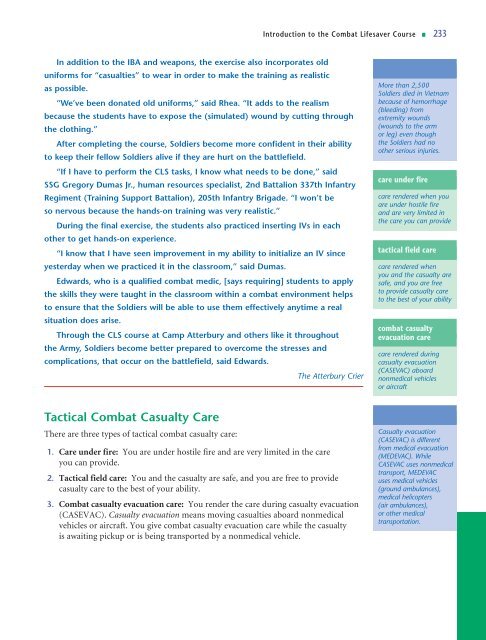introduction to the combat lifesaver course - UNC Charlotte Army ...
introduction to the combat lifesaver course - UNC Charlotte Army ...
introduction to the combat lifesaver course - UNC Charlotte Army ...
- No tags were found...
You also want an ePaper? Increase the reach of your titles
YUMPU automatically turns print PDFs into web optimized ePapers that Google loves.
Introduction <strong>to</strong> <strong>the</strong> Combat Lifesaver Course n 233In addition <strong>to</strong> <strong>the</strong> IBA and weapons, <strong>the</strong> exercise also incorporates olduniforms for “casualties” <strong>to</strong> wear in order <strong>to</strong> make <strong>the</strong> training as realisticas possible.“We’ve been donated old uniforms,” said Rhea. “It adds <strong>to</strong> <strong>the</strong> realismbecause <strong>the</strong> students have <strong>to</strong> expose <strong>the</strong> (simulated) wound by cutting through<strong>the</strong> clothing.”After completing <strong>the</strong> <strong>course</strong>, Soldiers become more confident in <strong>the</strong>ir ability<strong>to</strong> keep <strong>the</strong>ir fellow Soldiers alive if <strong>the</strong>y are hurt on <strong>the</strong> battlefield.“If I have <strong>to</strong> perform <strong>the</strong> CLS tasks, I know what needs <strong>to</strong> be done,” saidSSG Gregory Dumas Jr., human resources specialist, 2nd Battalion 337th InfantryRegiment (Training Support Battalion), 205th Infantry Brigade. “I won’t beso nervous because <strong>the</strong> hands-on training was very realistic.”During <strong>the</strong> final exercise, <strong>the</strong> students also practiced inserting IVs in eacho<strong>the</strong>r <strong>to</strong> get hands-on experience.“I know that I have seen improvement in my ability <strong>to</strong> initialize an IV sinceyesterday when we practiced it in <strong>the</strong> classroom,” said Dumas.Edwards, who is a qualified <strong>combat</strong> medic, [says requiring] students <strong>to</strong> apply<strong>the</strong> skills <strong>the</strong>y were taught in <strong>the</strong> classroom within a <strong>combat</strong> environment helps<strong>to</strong> ensure that <strong>the</strong> Soldiers will be able <strong>to</strong> use <strong>the</strong>m effectively anytime a realsituation does arise.Through <strong>the</strong> CLS <strong>course</strong> at Camp Atterbury and o<strong>the</strong>rs like it throughout<strong>the</strong> <strong>Army</strong>, Soldiers become better prepared <strong>to</strong> overcome <strong>the</strong> stresses andcomplications, that occur on <strong>the</strong> battlefield, said Edwards.The Atterbury CrierMore than 2,500Soldiers died in Vietnambecause of hemorrhage(bleeding) fromextremity wounds(wounds <strong>to</strong> <strong>the</strong> armor leg) even though<strong>the</strong> Soldiers had noo<strong>the</strong>r serious injuries.care under firecare rendered when youare under hostile fireand are very limited in<strong>the</strong> care you can providetactical field carecare rendered whenyou and <strong>the</strong> casualty aresafe, and you are free<strong>to</strong> provide casualty care<strong>to</strong> <strong>the</strong> best of your ability<strong>combat</strong> casualtyevacuation carecare rendered duringcasualty evacuation(CASEVAC) aboardnonmedical vehiclesor aircraftTactical Combat Casualty CareThere are three types of tactical <strong>combat</strong> casualty care:1. Care under fire: You are under hostile fire and are very limited in <strong>the</strong> careyou can provide.2. Tactical field care: You and <strong>the</strong> casualty are safe, and you are free <strong>to</strong> providecasualty care <strong>to</strong> <strong>the</strong> best of your ability.3. Combat casualty evacuation care: You render <strong>the</strong> care during casualty evacuation(CASEVAC). Casualty evacuation means moving casualties aboard nonmedicalvehicles or aircraft. You give <strong>combat</strong> casualty evacuation care while <strong>the</strong> casualtyis awaiting pickup or is being transported by a nonmedical vehicle.Casualty evacuation(CASEVAC) is differentfrom medical evacuation(MEDEVAC). WhileCASEVAC uses nonmedicaltransport, MEDEVACuses medical vehicles(ground ambulances),medical helicopters(air ambulances),or o<strong>the</strong>r medicaltransportation.
















